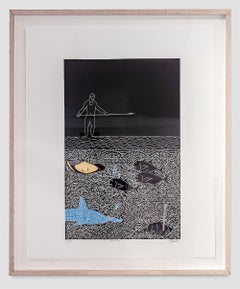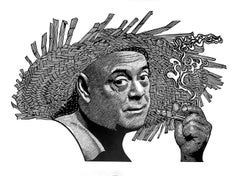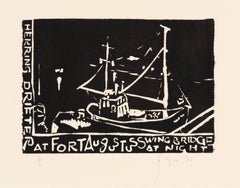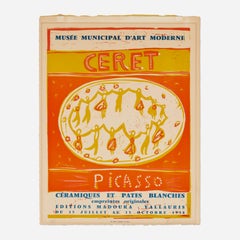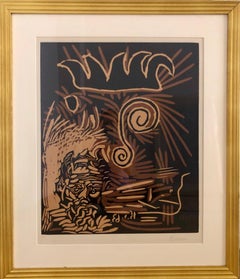Art by Medium: Linocut
to
301
629
191
261
85
49
Overall Width
to
Overall Height
to
1
656
561
4
14
66
32
74
130
86
115
74
423
206
106
55
23
18
14
7
7
5
2
1
598
502
114
383
205
178
139
130
123
102
96
86
65
64
61
59
42
39
38
31
30
30
29
1,218
184,018
96,969
77,933
75,936
73
43
38
31
24
124
228
589
518
Medium: Linocut
Gathiya Sanik
Located in London, GB
Limited edition print no. 2/10
Torres Strait Island artist David Bosun is from the tribe of Wug on Moa Island and grew up in a very sensitive cultural environment. From the age of ...
Category
2010s Contemporary Art by Medium: Linocut
Materials
Linocut
Elder, My Dear Elder : linocut print
Located in New York, NY
FDEZ’s artwork draws on allegory, sarcasm, symbolism & impactful images, to compose works that critique social and political issues from the world we live in, with the intent to capt...
Category
2010s Contemporary Art by Medium: Linocut
Materials
Linocut
Herring Drifter at Fort Augustus
Located in London, GB
Linocut on paper
Category
1970s Art by Medium: Linocut
Materials
Linocut
Musée Municipal D’Art Moderne Céret
Located in Laguna Beach, CA
Signed and numbered to lower margin ‘46/125 Picasso’. This work is number 46 from the edition of 125 printed by Arnéra, Vallauris and published by Musée Municipal d'Art Moderne, Cére...
Category
Mid-20th Century Art by Medium: Linocut
Materials
Linocut
Price Upon Request
Tetes: Le Vieux Buffon (Bloch 1104), Signed Picasso Linocut
Located in New York, NY
Linoleum cut printed in colours, 1963, on Arches woven paper, signed in pencil and numbered 30/50. Printed by Hidalgo Arnéra, and published by Galerie Louise Leiris, Paris.
Category
1960s Modern Art by Medium: Linocut
Materials
Linocut
Le Vase de Fleurs (BL. 914; Baer 1242), Pablo Picasso Signed Linocut
Located in New York, NY
Pablo Picasso (1881-1973)
Le Vase de Fleurs (BL. 914; Baer 1242), 1959
Hand-signed in pencil
Linocut in colors on Arches paper
Image: 25 ¼ x 21 in. (641 x 533 mm.)
Sheet: 29 5/8 x 24...
Category
1950s Art by Medium: Linocut
Materials
Linocut
Then Came a Stick and Beat the Dog, 1984
By Frank Stella
Located in Palo Alto, CA
Then Came a Stick and Beat the Dog, 1984 is a stellar example of his use of incredibly bright colors and a plethora of irregular shapes. The first thing you notice about this piece besides its colossal size is the color palette. The colors are highly saturated and vibrant; they carry a certain narrative, heavy quality that speaks to you. To name a few, Stella uses electrifying colors of magenta, pink, silver, brown, green, lavender, and aquamarine. These hues dazzle in plain sight but also accentuate the disorderly shapes of cones and cylinders. The outlines of these forms spill over the edge of the paper while the magical swirls of lines occupy your vision. The diversity in texture and layering of color on top of each other heightens the sense of mass and weight incorporated into this work.
The rhythmic lines and experimental quality of irregular shapes compose a kind of poetic allure. Inspired by gouaches done by the Russian avant-garde artist, El Lissitsky, Stella takes on a fresh new rendition. El Lissitzky’s works that Stella had seen in Tel Aviv were based on a song called “Had Gadya.” Stella designated titles for each variant in the series that becomes very much a part of his style as an artist. This piece is an example that highlights Stella as an artist who fuses inspiration from his well-traveled life into an aesthetically and culturally pleasing work of art. In all of this work’s interwoven structures, layered colors, and historic background, lies the mastery of Frank Stella, as a distinct artist in his ability to combine a vast array of elements.
Created in 1984, Then Came a Stick and Beat the Dog, 1984 from Illustrations After El Lissitzky's Had Gadya is a hand-coloring and collage with lithograph, linocut, and silkscreen on T. H. Saunders paper (background) and shaped, hand-cut Somerset paper (collage). Hand-signed and dated by Frank Stella (Massachusetts, 1936 - ) in pencil in the lower left: ‘F. Stella ‘84’, this work is numbered from the edition of 60 in pencil in the left; published by Waddington Graphics, London.
Catalogue Raisonné & COA:
Frank Stella Then Came...
Category
1980s Modern Art by Medium: Linocut
Materials
Lithograph, Linocut, Screen
Price Upon Request
Sunrise 1
By Alex Katz
Located in Fort Lauderdale, FL
Alex Katz was born in Brooklyn, New York in 1927. In 1928, at the outset of the Depression, his family moved to St. Albans, a diverse suburb of Queens that had sprung up between the two wars. Katz was raised in St. Albans by his Russian parents. His mother had been an actress and possessed a deep interest in poetry and his father, a businessman, also had an interest in the arts. Katz attended Woodrow Wilson High School for its unique program that allowed him to devote his mornings to academics and his afternoons to the arts. In 1946, Katz entered The Cooper Union Art School in Manhattan, a prestigious college of art, architecture, and engineering. At The Cooper Union, Katz studied painting under Morris Kantor and was trained in Modern art theories and techniques. Upon graduating in 1949, Katz was awarded a scholarship for summer study at the Skowhegan School for Painting and Sculpture in Maine, a grant that he would renew the following summer.
During his years at Cooper Union, Katz had been exposed primarily to modern art and was taught to paint from drawings. Skowhegan exposed him to painting from life, which would prove pivotal in his development as a painter and remains a staple of his practices today. Katz explains that Skowhegan’s plein air painting gave him “a reason to devote my life to painting.” Katz’s first one-person show was held at the Roko Gallery in 1954. Katz had begun to develop greater acquaintances with the New York School and their allies in the other arts; he counted amongst his friends’ figurative painters Larry Rivers and Fairfield Porter, photographer Rudolph Burckhardt, and poets John Ashbery, Edwin Denby, Frank O’Hara, and James Schuyler. From 1955 to 1959, usually following a day of painting, Katz made small collages of figures in landscapes from hand-colored strips of delicately cut paper.
In the late 1950s, he moved towards greater realism in his paintings. Katz became increasingly interested in portraiture, and painted his friends and his wife and muse, Ada. He embraced monochrome backgrounds, which would become a defining characteristic of his style, anticipating Pop Art and separating him from gestural figure painters and the New Perceptual Realism. In 1959, Katz made his first cutout, which would grow into a series of flat “sculptures;” freestanding or relief portraits that exist in actual space.
In the early 1960s, influenced by films, television, and billboard advertising, Katz began painting large-scale paintings, often with dramatically cropped faces. In 1965, he also embarked on a prolific career in printmaking. Katz would go on to produce many editions in lithography, etching, silkscreen, woodcut and linoleum cut. After 1964, Katz increasingly portrayed groups of figures.
He would continue painting these complex groups into the 1970s, portraying the social world of painters, poets, critics, and other colleagues that surrounded him. He began designing sets and costumes for choreographer Paul Taylor in the early 1960s, and he has painted many images of dancers throughout the years. In the 1980s, Katz took on a new subject in his work: fashion models in designer clothing. In the late 1980s and 1990s, Katz focused much of his attention on large landscape paintings, which he characterizes as “environmental.” Rather than observing a scene from afar, the viewer feels enveloped by nearby nature. Katz began each of these canvases with “an idea of the landscape, a conception,” trying to find the image in nature afterwards. In his landscape paintings, Katz loosened the edges of the forms, executing the works with greater painterliness than before in these allover canvases. In 1986, Katz began painting a series of night pictures—a sharp departure from the sunlit landscapes he had previously painted, forcing him to explore a new type of light. Variations on the theme of light falling through branches appear in Katz’s work throughout the 1990s and into the 21st century.
At the beginning of the new millennium, Katz also began painting flowers in profusion, covering canvases in blossoms similar to those he had first explored in the late 1960s, when he painted large close-ups of flowers in solitude or in small clusters. More recently Katz began painting a series of dancers and one of nudes, which was the subject of a 2011 exhibition at the Kestnergesellschaft in Hanover. Katz’s work continues to grow and evolve today. Alex Katz's work has been the subject of more than 200 solo exhibitions and nearly 500 group exhibitions internationally since 1951. In 2010, Alex Katz Prints was on view at the Albertina Museum in Vienna, which showed a retrospective survey of over 150 graphic works from a recent donation to the museum by Katz of his complete graphic oeuvre. The National Portrait Gallery in London presented an exhibition titled Alex Katz Portraits.
In June 2010, The Farnsworth Art Museum in Rockland, Maine opened Alex Katz: New Work, exhibiting recent large-scale paintings inspired by his summers spent in Maine. Katz was also represented in a show at the Metropolitan Museum of Art, New York, curated by Marla Prather, entitled Facing the Figure: Selections from the Permanent Collection, 2010. In 2009-2010, Alex Katz: An American Way Of Seeing was on view at the Sara Hildén Art Museum, Tampere, Finland; Musée Grenoble, Grenoble, France; and the Museum Kurhaus Kleve, Kleve, Germany. In 2007, Alex Katz: New York opened at the Irish Museum of Modern Art, Dublin, Ireland. The show, which included approximately 40 paintings and aquatints, was the first exhibition to concentrate primarily on Katz’s relationship with his native city.
The Jewish Museum, New York, presented Alex Katz Paints Ada in 2006-2007, an exhibition of 40 paintings focused on Katz’s wife, Ada, dating from 1957 to 2005. It coincided with an exhibition devoted to Katz’s paintings of the 1960s at PaceWildenstein, Alex Katz: The Sixties, on view from April 27 through June 17, 2006 at 545 West 22nd Street. Alex Katz in Maine, an exhibition of landscapes and portraits made over six decades, opened at The Farnsworth Art Museum and Wyeth...
Category
2010s Contemporary Art by Medium: Linocut
Materials
Linocut
Price Upon Request
Nicole (12/12)
By Alex Katz
Located in Fort Lauderdale, FL
Alex Katz was born in Brooklyn, New York in 1927. In 1928, at the outset of the Depression, his family moved to St. Albans, a diverse suburb of Queens that had sprung up between the two wars. Katz was raised in St. Albans by his Russian parents. His mother had been an actress and possessed a deep interest in poetry and his father, a businessman, also had an interest in the arts. Katz attended Woodrow Wilson High School for its unique program that allowed him to devote his mornings to academics and his afternoons to the arts. In 1946, Katz entered The Cooper Union Art School in Manhattan, a prestigious college of art, architecture, and engineering. At The Cooper Union, Katz studied painting under Morris Kantor and was trained in Modern art theories and techniques. Upon graduating in 1949, Katz was awarded a scholarship for summer study at the Skowhegan School for Painting and Sculpture in Maine, a grant that he would renew the following summer.
During his years at Cooper Union, Katz had been exposed primarily to modern art and was taught to paint from drawings. Skowhegan exposed him to painting from life, which would prove pivotal in his development as a painter and remains a staple of his practices today. Katz explains that Skowhegan’s plein air painting gave him “a reason to devote my life to painting.” Katz’s first one-person show was held at the Roko Gallery in 1954. Katz had begun to develop greater acquaintances with the New York School and their allies in the other arts; he counted amongst his friends’ figurative painters Larry Rivers and Fairfield Porter, photographer Rudolph Burckhardt, and poets John Ashbery, Edwin Denby, Frank O’Hara, and James Schuyler. From 1955 to 1959, usually following a day of painting, Katz made small collages of figures in landscapes from hand-colored strips of delicately cut paper.
In the late 1950s, he moved towards greater realism in his paintings. Katz became increasingly interested in portraiture, and painted his friends and his wife and muse, Ada. He embraced monochrome backgrounds, which would become a defining characteristic of his style, anticipating Pop Art and separating him from gestural figure painters and the New Perceptual Realism. In 1959, Katz made his first cutout, which would grow into a series of flat “sculptures;” freestanding or relief portraits that exist in actual space.
In the early 1960s, influenced by films, television, and billboard advertising, Katz began painting large-scale paintings, often with dramatically cropped faces. In 1965, he also embarked on a prolific career in printmaking. Katz would go on to produce many editions in lithography, etching, silkscreen, woodcut and linoleum cut. After 1964, Katz increasingly portrayed groups of figures.
He would continue painting these complex groups into the 1970s, portraying the social world of painters, poets, critics, and other colleagues that surrounded him. He began designing sets and costumes for choreographer Paul Taylor in the early 1960s, and he has painted many images of dancers throughout the years. In the 1980s, Katz took on a new subject in his work: fashion models in designer clothing. In the late 1980s and 1990s, Katz focused much of his attention on large landscape paintings, which he characterizes as “environmental.” Rather than observing a scene from afar, the viewer feels enveloped by nearby nature. Katz began each of these canvases with “an idea of the landscape, a conception,” trying to find the image in nature afterwards. In his landscape paintings, Katz loosened the edges of the forms, executing the works with greater painterliness than before in these allover canvases. In 1986, Katz began painting a series of night pictures—a sharp departure from the sunlit landscapes he had previously painted, forcing him to explore a new type of light. Variations on the theme of light falling through branches appear in Katz’s work throughout the 1990s and into the 21st century.
At the beginning of the new millennium, Katz also began painting flowers in profusion, covering canvases in blossoms similar to those he had first explored in the late 1960s, when he painted large close-ups of flowers in solitude or in small clusters. More recently Katz began painting a series of dancers and one of nudes, which was the subject of a 2011 exhibition at the Kestnergesellschaft in Hanover. Katz’s work continues to grow and evolve today. Alex Katz's work has been the subject of more than 200 solo exhibitions and nearly 500 group exhibitions internationally since 1951. In 2010, Alex Katz Prints was on view at the Albertina Museum in Vienna, which showed a retrospective survey of over 150 graphic works from a recent donation to the museum by Katz of his complete graphic oeuvre. The National Portrait Gallery in London presented an exhibition titled Alex Katz Portraits.
In June 2010, The Farnsworth Art Museum in Rockland, Maine opened Alex Katz: New Work, exhibiting recent large-scale paintings inspired by his summers spent in Maine. Katz was also represented in a show at the Metropolitan Museum of Art, New York, curated by Marla Prather, entitled Facing the Figure: Selections from the Permanent Collection, 2010. In 2009-2010, Alex Katz: An American Way Of Seeing was on view at the Sara Hildén Art Museum, Tampere, Finland; Musée Grenoble, Grenoble, France; and the Museum Kurhaus Kleve, Kleve, Germany. In 2007, Alex Katz: New York opened at the Irish Museum of Modern Art, Dublin, Ireland. The show, which included approximately 40 paintings and aquatints, was the first exhibition to concentrate primarily on Katz’s relationship with his native city.
The Jewish Museum, New York, presented Alex Katz Paints Ada in 2006-2007, an exhibition of 40 paintings focused on Katz’s wife, Ada, dating from 1957 to 2005. It coincided with an exhibition devoted to Katz’s paintings of the 1960s at PaceWildenstein, Alex Katz: The Sixties, on view from April 27 through June 17, 2006 at 545 West 22nd Street. Alex Katz in Maine, an exhibition of landscapes and portraits made over six decades, opened at The Farnsworth Art Museum and Wyeth...
Category
2010s Contemporary Art by Medium: Linocut
Materials
Linocut
Price Upon Request
Halsey (12/12)
By Alex Katz
Located in Fort Lauderdale, FL
Alex Katz was born in Brooklyn, New York in 1927. In 1928, at the outset of the Depression, his family moved to St. Albans, a diverse suburb of Queens that had sprung up between the two wars. Katz was raised in St. Albans by his Russian parents. His mother had been an actress and possessed a deep interest in poetry and his father, a businessman, also had an interest in the arts. Katz attended Woodrow Wilson High School for its unique program that allowed him to devote his mornings to academics and his afternoons to the arts. In 1946, Katz entered The Cooper Union Art School in Manhattan, a prestigious college of art, architecture, and engineering. At The Cooper Union, Katz studied painting under Morris Kantor and was trained in Modern art theories and techniques. Upon graduating in 1949, Katz was awarded a scholarship for summer study at the Skowhegan School for Painting and Sculpture in Maine, a grant that he would renew the following summer.
During his years at Cooper Union, Katz had been exposed primarily to modern art and was taught to paint from drawings. Skowhegan exposed him to painting from life, which would prove pivotal in his development as a painter and remains a staple of his practices today. Katz explains that Skowhegan’s plein air painting gave him “a reason to devote my life to painting.” Katz’s first one-person show was held at the Roko Gallery in 1954. Katz had begun to develop greater acquaintances with the New York School and their allies in the other arts; he counted amongst his friends’ figurative painters Larry Rivers and Fairfield Porter, photographer Rudolph Burckhardt, and poets John Ashbery, Edwin Denby, Frank O’Hara, and James Schuyler. From 1955 to 1959, usually following a day of painting, Katz made small collages of figures in landscapes from hand-colored strips of delicately cut paper.
In the late 1950s, he moved towards greater realism in his paintings. Katz became increasingly interested in portraiture, and painted his friends and his wife and muse, Ada. He embraced monochrome backgrounds, which would become a defining characteristic of his style, anticipating Pop Art and separating him from gestural figure painters and the New Perceptual Realism. In 1959, Katz made his first cutout, which would grow into a series of flat “sculptures;” freestanding or relief portraits that exist in actual space.
In the early 1960s, influenced by films, television, and billboard advertising, Katz began painting large-scale paintings, often with dramatically cropped faces. In 1965, he also embarked on a prolific career in printmaking. Katz would go on to produce many editions in lithography, etching, silkscreen, woodcut and linoleum cut. After 1964, Katz increasingly portrayed groups of figures.
He would continue painting these complex groups into the 1970s, portraying the social world of painters, poets, critics, and other colleagues that surrounded him. He began designing sets and costumes for choreographer Paul Taylor in the early 1960s, and he has painted many images of dancers throughout the years. In the 1980s, Katz took on a new subject in his work: fashion models in designer clothing. In the late 1980s and 1990s, Katz focused much of his attention on large landscape paintings, which he characterizes as “environmental.” Rather than observing a scene from afar, the viewer feels enveloped by nearby nature. Katz began each of these canvases with “an idea of the landscape, a conception,” trying to find the image in nature afterwards. In his landscape paintings, Katz loosened the edges of the forms, executing the works with greater painterliness than before in these allover canvases. In 1986, Katz began painting a series of night pictures—a sharp departure from the sunlit landscapes he had previously painted, forcing him to explore a new type of light. Variations on the theme of light falling through branches appear in Katz’s work throughout the 1990s and into the 21st century.
At the beginning of the new millennium, Katz also began painting flowers in profusion, covering canvases in blossoms similar to those he had first explored in the late 1960s, when he painted large close-ups of flowers in solitude or in small clusters. More recently Katz began painting a series of dancers and one of nudes, which was the subject of a 2011 exhibition at the Kestnergesellschaft in Hanover. Katz’s work continues to grow and evolve today. Alex Katz's work has been the subject of more than 200 solo exhibitions and nearly 500 group exhibitions internationally since 1951. In 2010, Alex Katz Prints was on view at the Albertina Museum in Vienna, which showed a retrospective survey of over 150 graphic works from a recent donation to the museum by Katz of his complete graphic oeuvre. The National Portrait Gallery in London presented an exhibition titled Alex Katz Portraits.
In June 2010, The Farnsworth Art Museum in Rockland, Maine opened Alex Katz: New Work, exhibiting recent large-scale paintings inspired by his summers spent in Maine. Katz was also represented in a show at the Metropolitan Museum of Art, New York, curated by Marla Prather, entitled Facing the Figure: Selections from the Permanent Collection, 2010. In 2009-2010, Alex Katz: An American Way Of Seeing was on view at the Sara Hildén Art Museum, Tampere, Finland; Musée Grenoble, Grenoble, France; and the Museum Kurhaus Kleve, Kleve, Germany. In 2007, Alex Katz: New York opened at the Irish Museum of Modern Art, Dublin, Ireland. The show, which included approximately 40 paintings and aquatints, was the first exhibition to concentrate primarily on Katz’s relationship with his native city.
The Jewish Museum, New York, presented Alex Katz Paints Ada in 2006-2007, an exhibition of 40 paintings focused on Katz’s wife, Ada, dating from 1957 to 2005. It coincided with an exhibition devoted to Katz’s paintings of the 1960s at PaceWildenstein, Alex Katz: The Sixties, on view from April 27 through June 17, 2006 at 545 West 22nd Street. Alex Katz in Maine, an exhibition of landscapes and portraits made over six decades, opened at The Farnsworth Art Museum and Wyeth...
Category
2010s Contemporary Art by Medium: Linocut
Materials
Linocut
Price Upon Request
Satyr, Nymph and Cupid (Tropic of Cancer), Linocut by Benno 1935
Located in Long Island City, NY
A risquee Modern print depicting a Cupid observing his good work on a Satyr & Nymph. The Bacchanalia has reached it's desired conclusion. This is an original 1935 linocut print on wo...
Category
1930s Modern Art by Medium: Linocut
Materials
Linocut
Red Samurai, from Octavio Paz suite
Located in Miami, FL
TECHNICAL INFORMATION:
Red Samurai, from Octavio Paz suite
1987-88
Lithograph and linoleum cut in colors with chine appliqué on handmade Japanese Masa Dos...
Category
1980s Abstract Expressionist Art by Medium: Linocut
Materials
Handmade Paper, Lithograph, Linocut
Price Upon Request
Untitled (Figure)
Located in Santa Monica, CA
Original color linoleum cut
Category
1970s Art by Medium: Linocut
Materials
Linocut
Price Upon Request
Man
Located in Missouri, MO
Elizabeth Catlett
“Man” 1975 (The Print Club of Cleveland Publication Number 83, 2005)
Woodcut and Color Linocut
Printed in 2003 at JK Fine Art Editions Co., Union City, New Jersey
Signed and Dated By The Artist Lower Right
Titled Lower Left
Ed. of 250
Image Size: approx 18 x 12 inches
Elizabeth Catlett (1915-2012) is regarded as one of the most important women artists and African American artists of our time. She believed art could affect social change and that she should be an agent for that change: “I have always wanted my art to service black people—to reflect us, to relate to us, to stimulate us, to make us aware of our potential.” As an artist and an activist, Catlett highlighted the dignity and courage of motherhood, poverty, and the working class, returning again and again to the subject she understood best—African American women.
The work below, entitled, “Man”, is "carved from a block of wood, chiseled like a relief. Catlett, a sculptor as well as a printmaker, carves figures out of wood, and so is extremely familiar with this material. For ‘Man’ she exploits the grain of the wood, allowing to to describe the texture of the skin and form vertical striations, almost scarring the image. Below this intense, three-dimensional visage parades seven boys, printed repetitively from a single linoleum block in a “rainbow roll” that changes from gold to brown. This row of brightly colored figures with bare feet, flat like a string of paper dolls, raise their arms toward the powerful depiction of the troubled man above.”
Biography:
Elizabeth Catlett (1915-2012)
Known for abstract sculpture in bronze and marble as well as prints and paintings, particularly depicting the female figure, Elizabeth Catlett is unique for distilling African American, Native American, and Mexican art in her work. She is "considered by many to be the greatest American black sculptor". . .(Rubinstein 320)
Catlett was born in Washington D.C. and later became a Mexican citizen, residing in Cuernavaca Morelos, Mexico. She spent the last 35 years of her life in Mexico.
Her father, a math teacher at Tuskegee Institute in Alabama, died before she was born, but the family, including her working mother, lived in the relatively commodious home of his family in DC. Catlett received a Bachelor of Arts degree from Howard University, where there was much discussion about whether or not black artists should depict their own heritage or embrace European modernism.
She earned a Master of Fine Arts degree in 1940 from the University of Iowa, where she had gone to study with Grant Wood, Regionalist* painter. His teaching dictum was "paint what you know best," and this advice set her on the path of dealing with her own background. She credits Wood with excellent teaching and deep concern for his students, but she had a problem during that time of taking classes from him because black students were not allowed housing in the University's dormitories.
Following graduation in 1940, she became Chair of the Art Department at Dillard University in New Orleans. There she successfully lobbied for life classes with nude models, and gained museum admission to black students at a local museum that to that point, had banned their entrance. That same year, her painting Mother and Child, depicting African-American figures won her much recognition.
From 1944 to 1946, she taught at the George Washington Carver School, an alternative community school in Harlem that provided instruction for working men and women of the city. From her experiences with these people, she did a series of paintings, prints, and sculptures with the theme "I Am a Negro Woman."
In 1946, she received a Rosenwald Fellowship*, and she and her artist husband, Charles White, traveled to Mexico where she became interested in the Mexican working classes. In 1947, she settled permanently in Mexico where she, divorced from White, married artist Francisco Mora...
Category
Late 19th Century American Modern Art by Medium: Linocut
Materials
Linocut, Woodcut
Price Upon Request
Arcs and Bands in Color - Contemporary Art, Linocut, Minimalism, Conceptual art
By Sol LeWitt
Located in London, GB
The set of six linocuts printed in colours.
Each signed in pencil, numbered from the edition of 50.
Printed on Somerset Velvet Radiant White paper by Hidemi Nomura and Tsutomu Kjimo...
Category
Early 2000s Minimalist Art by Medium: Linocut
Materials
Linocut
New York Times Leisure Section - print linocut contemporary art waterscape
Located in London, GB
Signed, dated and titled in pencil.
Inscribed 'AP', an artist's proof aside from the edition of 65.
Category
1990s Pop Art Art by Medium: Linocut
Materials
Linocut
Diurnes (Femme Assise En Pyjama De Plage II)
Located in Missouri, MO
Pablo Picasso
"Diurnes" (Femme Assise En Pyjama De Plage II) 1962
Linocut printed in ochre and brown, 1962, on Arches paper
Inscribed "Epreuve D'Artist" (Artist Proof) lower left, as...
Category
1960s Modern Art by Medium: Linocut
Materials
Linocut
Price Upon Request
Four Cities
By Alex Corno
Located in Dallas, TX
This portfolio, of four prints engraved on linoleum and printed on paper, includes the linocuts titled: Dallas, Amarillo, Albuquerque and Santa Fe.
Valley House Gallery & Sculptur...
Category
21st Century and Contemporary Abstract Art by Medium: Linocut
Materials
Linocut
Price Upon Request
Linocut art for sale on 1stDibs.
Find a wide variety of authentic Linocut art available on 1stDibs. While artists have worked in this medium across a range of time periods, art made with this material during the 21st Century is especially popular. If you’re looking to add art created with this material to introduce a provocative pop of color and texture to an otherwise neutral space in your home, the works available on 1stDibs include elements of blue, purple, orange, green and other colors. There are many well-known artists whose body of work includes ceramic sculptures. Popular artists on 1stDibs associated with pieces like this include Mino Maccari, (after) Pablo Picasso, Rob Barnes, and Pablo Picasso. Frequently made by artists working in the Contemporary, Modern, all of these pieces for sale are unique and many will draw the attention of guests in your home. Not every interior allows for large Linocut art, so small editions measuring 0.01 inches across are also available
